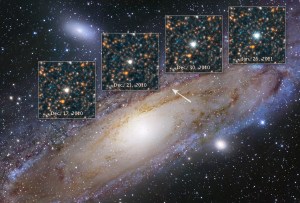

3 min read
NASA Solar Observatory Sees Coronal Loops Flicker Before Big Flares
For decades, scientists have tried in vain to accurately predict solar flares — intense bursts of light on the Sun that can send a flurry of charged particles into the solar system. Now, using NASA’s Solar Dynamics Observatory, one team has identified flickering loops in the solar atmosphere, or corona, that seem to signal when the Sun is about to unleash a large flare.
These warning signs could help NASA and other stakeholders protect astronauts as well as technology both in space and on the ground from hazardous space weather.
Led by heliophysicist Emily Mason of Predictive Sciences Inc. in San Diego, California, the team studied arch-like structures called coronal loops along the edge of the Sun. Coronal loops rise from magnetically driven active regions on the Sun, where solar flares also originate.
The team looked at coronal loops near 50 strong solar flares, analyzing how their brightness in extreme ultraviolet light varied in the hours before a flare compared to loops above non-flaring regions. Like flashing warning lights, the loops above flaring regions varied much more than those above non-flaring regions.
“We found that some of the extreme ultraviolet light above active regions flickers erratically for a few hours before a solar flare,” Mason explained. “The results are really important for understanding flares and may improve our ability to predict dangerous space weather.”
Published in the Astrophysical Journal Letters in December 2024 and presented on Jan. 15, 2025, at a press conference during the 245th meeting of the American Astronomical Society, the results also hint that the flickering reaches a peak earlier for stronger flares. However, the team says more observations are needed to confirm this link.
Other researchers have tried to predict solar flares by examining magnetic fields on the Sun, or by looking for consistent trends in other coronal loop features. However, Mason and her colleagues believe that measuring the brightness variations in coronal loops could provide more precise warnings than those methods — signaling oncoming flares 2 to 6 hours ahead of time with 60 to 80 percent accuracy.
“A lot of the predictive schemes that have been developed are still predicting the likelihood of flares in a given time period and not necessarily exact timing,” said team member Seth Garland of the Air Force Institute of Technology at Wright-Patterson Air Force Base in Ohio.
Each solar flare is like a snowflake — every single flare is unique.

Kara kniezewski
Air Force Institute of Technology
“The Sun’s corona is a dynamic environment, and each solar flare is like a snowflake — every single flare is unique,” said team member Kara Kniezewski, a graduate student at the Air Force Institute of Technology and lead author of the paper. “We find that searching for periods of ‘chaotic’ behavior in the coronal loop emission, rather than specific trends, provide a much more consistent metric and may also correlate with how strong a flare will be.”
The scientists hope their findings about coronal loops can eventually be used to help keep astronauts, spacecraft, electrical grids, and other assets safe from the harmful radiation that accompanies solar flares. For example, an automated system could look for brightness changes in coronal loops in real-time images from the Solar Dynamics Observatory and issue alerts.
“Previous work by other researchers reports some interesting prediction metrics,” said co-author Vadim Uritsky of NASA’s Goddard Space Flight Center in Greenbelt, Maryland, and the Catholic University of Washington in D.C. “We could build on this and come up with a well-tested and, ideally, simpler indicator ready for the leap from research to operations.”
By Vanessa Thomas
NASA’s Goddard Space Flight Center, Greenbelt, Md.







